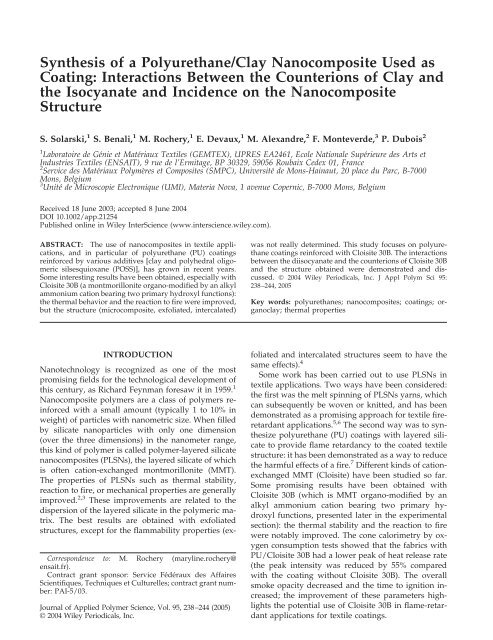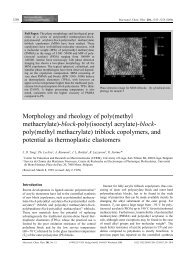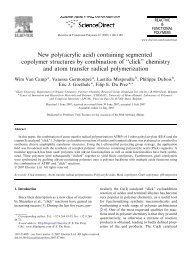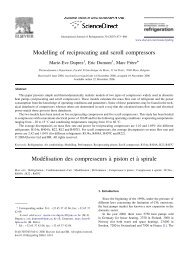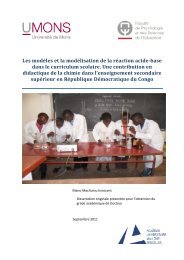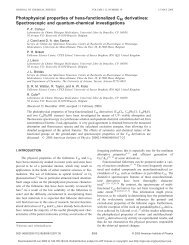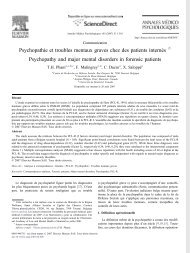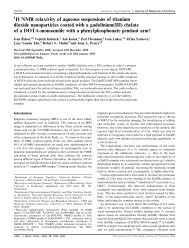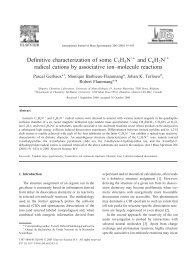Synthesis of a polyurethane/clay nanocomposite used as coating ...
Synthesis of a polyurethane/clay nanocomposite used as coating ...
Synthesis of a polyurethane/clay nanocomposite used as coating ...
You also want an ePaper? Increase the reach of your titles
YUMPU automatically turns print PDFs into web optimized ePapers that Google loves.
<strong>Synthesis</strong> <strong>of</strong> a Polyurethane/Clay Nanocomposite Used <strong>as</strong>Coating: Interactions Between the Counterions <strong>of</strong> Clay andthe Isocyanate and Incidence on the NanocompositeStructureS. Solarski, 1 S. Benali, 1 M. Rochery, 1 E. Devaux, 1 M. Alexandre, 2 F. Monteverde, 3 P. Dubois 21 Laboratoire de Génie et Matériaux Textiles (GEMTEX), UPRES EA2461, Ecole Nationale Supérieure des Arts etIndustries Textiles (ENSAIT), 9 rue de l’Ermitage, BP 30329, 59056 Roubaix Cedex 01, France2 Service des Matériaux Polymères et Composites (SMPC), Université de Mons-Hainaut, 20 place du Parc, B-7000Mons, Belgium3 Unité de Microscopie Electronique (UMI), Materia Nova, 1 avenue Copernic, B-7000 Mons, BelgiumReceived 18 June 2003; accepted 8 June 2004DOI 10.1002/app.21254Published online in Wiley InterScience (www.interscience.wiley.com).ABSTRACT: The use <strong>of</strong> <strong>nanocomposite</strong>s in textile applications,and in particular <strong>of</strong> <strong>polyurethane</strong> (PU) <strong>coating</strong>sreinforced by various additives [<strong>clay</strong> and polyhedral oligomericsilsesquioxane (POSS)], h<strong>as</strong> grown in recent years.Some interesting results have been obtained, especially withCloisite 30B (a montmorillonite organo-modified by an alkylammonium cation bearing two primary hydroxyl functions):the thermal behavior and the reaction to fire were improved,but the structure (microcomposite, exfoliated, intercalated)w<strong>as</strong> not really determined. This study focuses on <strong>polyurethane</strong><strong>coating</strong>s reinforced with Cloisite 30B. The interactionsbetween the diisocyanate and the counterions <strong>of</strong> Cloisite 30Band the structure obtained were demonstrated and discussed.© 2004 Wiley Periodicals, Inc. J Appl Polym Sci 95:238–244, 2005Key words: <strong>polyurethane</strong>s; <strong>nanocomposite</strong>s; <strong>coating</strong>s; organo<strong>clay</strong>;thermal propertiesINTRODUCTIONCorrespondence to: M. Rochery (maryline.rochery@ensait.fr).Contract grant sponsor: Service Fédéraux des AffairesScientifiques, Techniques et Culturelles; contract grant number:PAI-5/03.Journal <strong>of</strong> Applied Polymer Science, Vol. 95, 238–244 (2005)© 2004 Wiley Periodicals, Inc.Nanotechnology is recognized <strong>as</strong> one <strong>of</strong> the mostpromising fields for the technological development <strong>of</strong>this century, <strong>as</strong> Richard Feynman foresaw it in 1959. 1Nanocomposite polymers are a cl<strong>as</strong>s <strong>of</strong> polymers reinforcedwith a small amount (typically 1 to 10% inweight) <strong>of</strong> particles with nanometric size. When filledby silicate nanoparticles with only one dimension(over the three dimensions) in the nanometer range,this kind <strong>of</strong> polymer is called polymer-layered silicate<strong>nanocomposite</strong>s (PLSNs), the layered silicate <strong>of</strong> whichis <strong>of</strong>ten cation-exchanged montmorillonite (MMT).The properties <strong>of</strong> PLSNs such <strong>as</strong> thermal stability,reaction to fire, or mechanical properties are generallyimproved. 2,3 These improvements are related to thedispersion <strong>of</strong> the layered silicate in the polymeric matrix.The best results are obtained with exfoliatedstructures, except for the flammability properties (exfoliatedand intercalated structures seem to have thesame effects). 4Some work h<strong>as</strong> been carried out to use PLSNs intextile applications. Two ways have been considered:the first w<strong>as</strong> the melt spinning <strong>of</strong> PLSNs yarns, whichcan subsequently be woven or knitted, and h<strong>as</strong> beendemonstrated <strong>as</strong> a promising approach for textile fireretardantapplications. 5,6 The second way w<strong>as</strong> to synthesize<strong>polyurethane</strong> (PU) <strong>coating</strong>s with layered silicateto provide flame retardancy to the coated textilestructure: it h<strong>as</strong> been demonstrated <strong>as</strong> a way to reducethe harmful effects <strong>of</strong> a fire. 7 Different kinds <strong>of</strong> cationexchangedMMT (Cloisite) have been studied so far.Some promising results have been obtained withCloisite 30B (which is MMT organo-modified by analkyl ammonium cation bearing two primary hydroxylfunctions, presented later in the experimentalsection): the thermal stability and the reaction to firewere notably improved. The cone calorimetry by oxygenconsumption tests showed that the fabrics withPU/Cloisite 30B had a lower peak <strong>of</strong> heat rele<strong>as</strong>e rate(the peak intensity w<strong>as</strong> reduced by 55% comparedwith the <strong>coating</strong> without Cloisite 30B). The overallsmoke opacity decre<strong>as</strong>ed and the time to ignition incre<strong>as</strong>ed;the improvement <strong>of</strong> these parameters highlightsthe potential use <strong>of</strong> Cloisite 30B in flame-retardantapplications for textile <strong>coating</strong>s.
240 SOLARSKI ET AL.Wide-angle X-ray diffraction (WAXD) at low-angleregionA PU/MMT sample w<strong>as</strong> molded (just after the secondstage <strong>of</strong> synthesis <strong>of</strong> PU/MMT) into a plate to give <strong>as</strong>olid sample (20 20 2 mm thick). These sampleswere <strong>used</strong> to collect XRD data on a Siemens D500diffractometer (University <strong>of</strong> Reading, UK), Cu–K radiation ( 1.5406 nm) with a 0.02° 2 step size anda 2-s step time, within the scan range <strong>of</strong> 1–10°.Figure 3 Curve <strong>of</strong> titration <strong>of</strong> the quantity NCO functionsin the IPDI solution.(C 4 H 9 ) 2 NHremaining DBAH hydrochloric acid3 (C 4 H 9 ) 2 NH 2(2)The titration <strong>of</strong> the remaining DBA w<strong>as</strong> carried out bya pH metric method (pHM210 MeterLab, RadiometerAnalytical, London, UK). The equivalent volume w<strong>as</strong>graphically determined according to the cl<strong>as</strong>sicalmethod <strong>of</strong> tangents. The pure IPDI and the mixtureIPDI/Cloisite 30B were me<strong>as</strong>ured.The second method <strong>used</strong> w<strong>as</strong> infrared spectroscopy.The me<strong>as</strong>urements were performed with a Nexus 870spectrometer (Nicolet Analytical Instruments, Madison,WI). The samples (mixture IPDI/C30B) wereplaced between two KBr pellets obtained from finelycrushed KBr powder. The sample w<strong>as</strong> then placed inthe spectrophotometer chamber swept by a flow <strong>of</strong>dry air. The are<strong>as</strong> <strong>of</strong> the different peaks at the initialtime and at the final time were then determined. Theone concerning the NCO peak (2257 cm 1 ) varied, andthis variation w<strong>as</strong> compared with the area <strong>of</strong> the CH 2peak considered <strong>as</strong> constant (2600–3030 cm 1 )toobtainthe concentration <strong>of</strong> IPDI.Thermogravimetric analysis (TGA)TG analyses were performed using a Netzsch STA449C thermobalance (Netzsch-Gerätebau GmbH, Bavaria,Germany) at 10°C/min, from 20 to 1000°C, underflowing air (60 mL/min). Samples ( 10 mg) wereplaced in open platinum pans. The precision on temperatureme<strong>as</strong>urements w<strong>as</strong> 0.5°C.RESULTS AND DISCUSSIONAssessment <strong>of</strong> the IPDI consumed by counterions<strong>of</strong> Cloisite 30BBy back titration <strong>of</strong> NCOThe method by back titration gave an equivalent volume<strong>of</strong> 5.3 mL for the pure IPDI (see Fig. 3). Thespecific rate <strong>of</strong> isocyanate functions w<strong>as</strong> determinedusing the following equation:with%NCO 100 n NCO M NCOm IPDI(3)n NCO p DBA m DBA C a V eM DBA 1000(4)where % NCO is the specific rate <strong>of</strong> isocyanate functions,that is, the m<strong>as</strong>s percentage <strong>of</strong> available isocyanatefunctions relative to the m<strong>as</strong>s <strong>of</strong> analyzed IPDI;Transmission electron microscopy (TEM)TEM images were obtained using a CM 200 microscope(Philips, Eindhoven, The Netherlands) at anaccelerated voltage <strong>of</strong> 120 kV. Ultrathin sections (80nm) were prepared at 130°C using a UCT ultramicrotomeequipped with an FCS cryochamber (bothfrom Leica Mikrosysteme GmbH, Wetzlar, Germany).Figure 4Reaction between IPDI and a counterion.
PU/CLAY NANOCOMPOSITE USED AS COATING 241rNCO NCO 0 NCONCO 0 1 ANCOt f ACH 2 t 0 ACH 2 t f ANCOt 0 (5)Figure 5 Curve <strong>of</strong> titration <strong>of</strong> the quantity NCO functionsin the IPDI/Cloisite 30B mixture.where [NCO] 0 is the concentration <strong>of</strong> NCO at theinitial time; A(NCO)[t 0 ] and A(NCO)[t f ] are the integratedabsorbances <strong>of</strong> NCO at the initial time (t 0 ) andthe final time (t f ) <strong>of</strong> the reaction with (NCO) 2257cm 1 ; and A(CH 2 )[t 0 ] and A(CH 2 )[t f ] are the integratedabsorbances <strong>of</strong> CH 2 and CH 3 at the initial time (t 0 ) andthe final time (t f ) <strong>of</strong> the reaction with (CH 2 ) [2600–3030] cm 1 .The initial time corresponded to the spectrum <strong>of</strong> themixture after a few minutes <strong>of</strong> stirring <strong>of</strong> IPDI andCloisite 30B. Three spectra corresponding to the initialtime were carried out. The final time w<strong>as</strong> determinedafter the stabilization <strong>of</strong> A(NCO)[t f ]/A(CH 2 )[t f ]. In Fig-n NCOis the mole <strong>of</strong> titrated isocyanate functions;M NCO (42.02 g/mol) is the molar m<strong>as</strong>s <strong>of</strong> the isocyanatefunction; m IPDI is the m<strong>as</strong>s <strong>of</strong> IPDI <strong>used</strong> for thetitration; m DBA is the m<strong>as</strong>s <strong>of</strong> N-dibutylamine; M DBA(129.25 g/mol) is the molar m<strong>as</strong>s <strong>of</strong> N-dibutylamine;p DBA (0.995) is the purity <strong>of</strong> N-dibutylamine; V e isthe equivalent volume (mL); and C a is the concentration<strong>of</strong> the hydrochloric acid solution.The % NCO found w<strong>as</strong> 37.8%, which is in goodagreement with the supplier’s data (37.7–37.8%).The counterions <strong>of</strong> Cloisite 30B present two hydroxylgroups. It is thus possible to promote a reactionbetween IPDI and the counterions (see Fig. 4). Thismethod would lead to a <strong>polyurethane</strong> <strong>nanocomposite</strong>with mixed morphology (intercalated and exfoliated), 9but the reaction w<strong>as</strong> between the prepolymer and thecounterions. In our study, an IPDI monomer (IPDI)w<strong>as</strong> directly introduced to react with the counterions,and the quantity <strong>of</strong> IPDI reacting with counterionsw<strong>as</strong> evaluated; it is thus possible to adapt the quantity<strong>of</strong> chain extender (BD) to be added in the second stage<strong>of</strong> PU/MMT synthesis.The equivalent volume found for the IPDI/Cloisite30B mixture w<strong>as</strong> 5.9 mL (see Fig. 5), so the % NCOdecre<strong>as</strong>ed to 33.5%.By infrared spectroscopyTo confirm the previous results, some me<strong>as</strong>urementswere carried out by infrared spectroscopy. The specificrate <strong>of</strong> isocyanate functions (r[NCO]) w<strong>as</strong> determinedusing the following equation:Figure 6 Infrared spectra <strong>of</strong> IPDI, Cloisite 30B, and IPDI/Cloisite 30B at final time.
242 SOLARSKI ET AL.<strong>used</strong> to start some PU chains, which are grafted ontothe silicate layers, and this reaction should facilitatethe intercalation or the exfoliation <strong>of</strong> the layers <strong>of</strong>Cloisite 30B in the PU matrix. It is thus necessary toadapt the quantity <strong>of</strong> BD: only 2.7 mol <strong>of</strong> BD need be<strong>used</strong> <strong>as</strong> chain extender and not 3 mol.Figure 7 TEM image <strong>of</strong> an intercalated <strong>nanocomposite</strong>PU/Cloisite 30B.ure 6, the characteristic peaks <strong>of</strong> the IPDI ((NCO) 2257 cm 1 and (CH 2 ) and (CH 3 ) [2600–3030]cm 1 ) and the characteristic peak <strong>of</strong> hydroxyl group <strong>of</strong>the counterions <strong>of</strong> Cloisite 30B [(OH) 3300 cm 1 ]can be observed. For the IPDI/Cloisite 30B mixture atthe final time, we see that a new peak appeared at 1720cm 1 , corresponding to the CAO function, whichproves that the reaction between the NCO functions <strong>of</strong>IPDI and the OH functions <strong>of</strong> the counterions <strong>of</strong>Cloisite 30B occurs to form urethane links: r[NCO] 11.9% and the % NCO decre<strong>as</strong>es to 33.3%.The two methods allowed us to conclude that thereaction effectively occurs between IPDI and the counterions<strong>of</strong> Cloisite 30B. The counterions can then beTEMThe actual nature <strong>of</strong> a <strong>nanocomposite</strong> can be observedusing TEM images. Figure 7 shows a typical micrograph<strong>of</strong> the PU containing 5 wt % <strong>of</strong> Cloisite 30B. Thedark lines represent the sheets <strong>of</strong> Cloisite 30B, thethickness <strong>of</strong> which is about 1 nm. The spaces betweenthe dark lines represent the interlayer spaces. Asshown in this photograph, the structure <strong>of</strong> the <strong>nanocomposite</strong>seems to be rather an intercalated structure.No exfiolated sheet is observed in the PU matrix. Are<strong>as</strong>on that explains why we did not obtain an exfoliatedstructure is probably the high functionalization <strong>of</strong>the alcohol functions <strong>of</strong> the counterions <strong>of</strong> the Cloisite30B by the diisocyanate. During the chain growth,some crosslinking reactions can occur and this reactionshould prevent the exfoliation <strong>of</strong> the layers fromtaking place. The distance me<strong>as</strong>ured on the imagegives us an approximate interlayer distance <strong>of</strong> 3.8 nm.XRDTo better estimate the distance between two layers,XRD can be <strong>used</strong>. The WAXD curves <strong>of</strong> Cloisite 30Band PU/Cloisite 30B are shown in Figure 8. The curveconcerning Cloisite 30B presents a broad peak at 2 4.9°, which indicated that the d-spacing betweentwo silicate layers is about 1.9 nm {calculated withFigure 8 Wide-angle X-ray diffraction curves <strong>of</strong> Cloisite 30B and PU/Cloisite 30B.
PU/CLAY NANOCOMPOSITE USED AS COATING 243Figure 9 TG behavior <strong>of</strong> PU and PU/Cloisite 30B.Bragg’s law d /[2 sin()]}. This typical peak <strong>of</strong>Cloisite 30B disappeared on the IPDI/Cloisite 30Bcurve. This disappearance could be explained eitherby the exfoliation <strong>of</strong> the silicate or by a high disorder<strong>of</strong> the <strong>clay</strong>. 3 If the silicate layers were exfoliated, thed-spacing would become too high and could not bedetected by the XRD methods, and if the <strong>clay</strong>s werenot well ordered, it would fail to produce a Braggdiffraction peak. However, TEM experiments showedthe intercalated structure <strong>of</strong> PU/Cloisite 30B. It canthen be supposed that a peak should be observed atlower 2 values (at about 2.3°, this value w<strong>as</strong> calculatedfrom the interlayer distance me<strong>as</strong>ured on theTEM image).430°C and from 430 to 580°C, these stages correspondingto the results seen in the literature) and forms onlya residue <strong>of</strong> 0.1% <strong>of</strong> the initial weight. The PU/Cloisite30B presents a similar behavior (in two stages), but ismore thermally stable, particularly between 200 and320°C, that is, during the start <strong>of</strong> the decomposition(Fig. 10). Actually, we obtain 95% <strong>of</strong> the initial weight<strong>of</strong> PU at 250°C compared with 285°C for PU/Cloisite30B. It degrades totally at around 650°C by forming amore important residue ( 4.5%), which correspondsto the rest <strong>of</strong> Cloisite 30B. The <strong>clay</strong> can thus be considered<strong>as</strong> responsible for the improvement <strong>of</strong> thethermal stability.Thermogravimetric analysisA number <strong>of</strong> studies on the thermal degradation <strong>of</strong> PUhave previously been published. 10–20 The first stage <strong>of</strong>degradation <strong>of</strong> PU is mainly a reaction <strong>of</strong> depolymerization.10–13,15 This depolymerization starts generallybetween 200 and 250°C, and corresponds to the failure<strong>of</strong> urethane links, which leads to the rele<strong>as</strong>e <strong>of</strong> thepolyol and <strong>of</strong> the isocyanate <strong>used</strong> to synthesize the PUchains. The monomers then slowly volatilize, andthere is a pr<strong>of</strong>usion <strong>of</strong> secondary reactions (urea formation)and rearrangements. At 500°C, all the urethanegroups are decomposed and the final degradation<strong>of</strong> PU corresponds to the decomposition <strong>of</strong> ureagroups. 21TG curves <strong>of</strong> PU and PU/Cloisite 30B are shown inFigures 9 and 10. The general trend <strong>of</strong> the curvesallows to conclude that PU/Cloisite 30B h<strong>as</strong> a betterthermal stability than PU (Fig. 9). PU started to degradefrom 200°C in two main stages (from 200 toCONCLUSIONSThe original <strong>as</strong>pect <strong>of</strong> the synthesis <strong>of</strong> this <strong>polyurethane</strong><strong>nanocomposite</strong> w<strong>as</strong> to use the counterions <strong>of</strong> theCloisite 30B to initiate the growth <strong>of</strong> the PU chains.The reaction between the counterions <strong>of</strong> Cloisite 30Band IPDI w<strong>as</strong> evidenced by two different techniques(titration and infrared spectroscopy). The TEM observationsrevealed an intercalated structure, even if itw<strong>as</strong> difficult to precisely me<strong>as</strong>ure the exact d-spacing<strong>of</strong> the Cloisite 30B in the PU matrix because <strong>of</strong> apar<strong>as</strong>ite peak on the WAXD curves. The TG resultsshowed an improvement in the thermal stability, particularlyat the start <strong>of</strong> the degradation (an incre<strong>as</strong>e <strong>of</strong>35°C w<strong>as</strong> observed), in spite <strong>of</strong> the small amount <strong>of</strong>Cloisite 30B <strong>used</strong> (5 wt %). This improvement is betterthan that observed in the first study. 6 Thus, the process(which is different in this study) is substantiallyimportant in obtaining a good dispersion <strong>of</strong> theCloisite 30B in the PU matrix.
244 SOLARSKI ET AL.Figure 10TG behavior <strong>of</strong> PU and PU/Cloisite 30B during the start <strong>of</strong> decomposition.The authors acknowledge Mrs. Chlebicki for experimental<strong>as</strong>sistance in thermogravimetric analysis. Ph.D. and M.A.thank the Service Fédéraux des Affaires Scientifiques, Techniqueset Culturelles for general support under Grant PAI-5/03. The SMPC is much indebted to the Région Wallonneand the Fonds Social Européen for support within the frame<strong>of</strong> “Objectif 1-Hainaut: Materia Nova.”References1. Feynman, R. In: Proceedings <strong>of</strong> the Annual Meeting <strong>of</strong> theAmerican Physical Society at the California Institute <strong>of</strong> Technology,P<strong>as</strong>adena, CA, Dec 29, 1959.2. Alexandre, M.; Dubois, P. Mater Sci Eng Res 2000, 28, 1.3. Ishida, H.; Campbell, S.; Blackwell, J. Chem Mater 2001, 12,1260.4. Morgan, A. B.; Gilman, J. W. J Appl Polym Sci 2003, 87, 1329.5. Bourbigot, S.; Devaux, E.; Flambard, X. Polym Degrad Stab2002, 75, 397.6. Devaux, E.; Bourbigot, S.; El Achari, A. J Appl Polym Sci 2002,86, 2416.7. Devaux, E.; Rochery, M.; Bourbigot, S. Fire Mater 2002, 26, 149.8. Giraud, S. Ph.D. Thesis, ENSAIT, Université de Lille I, France,2002.9. Tien, Y. I.; Wei, K. H. J Appl Polym Sci 2002, 86, 1741.10. Saunders, J. H. Rubber Chem Technol 1959, 32, 337.11. Ingham, J. D.; Rapp, N. S. J Polym Sci Part A 1964, 2, 4941.12. Saunders, J. H.; Backus, J. K. Rubber Chem Technol 1966, 39,461.13. Yang, W. P.; Macosko, C. W.; Wellingh<strong>of</strong>f, S. T. Polymer 1986,27, 1235.14. Gr<strong>as</strong>sie, N.; Scott, G. In: Polymer Degradation and Stabilisation;Gr<strong>as</strong>sie, N.; Scott, G., Eds.; Cambridge University Press: Cambridge,UK, 1985; p. 39.15. Gr<strong>as</strong>sie, N.; Zulfiquar, M. J Polym Sci Polym Chem Ed 1978, 16,1563.16. Gr<strong>as</strong>sie, N.; Perdomo Mendoza, G. A. Polym Degrad Stab 1985,10, 267.17. Gr<strong>as</strong>sie, N.; Zulfiquar, M.; Guy, M. I. J Polym Sci Polym ChemEd 1980, 18.18. Shieh, Y. T.; Chen, H. T.; Liu, K. H.; Twu, Y. K. J Polym Sci PartA: Polym Chem 1999, 37, 4126.19. Thorne, M. P. Can J Chem 1967, 45, 2537.20. Ballistreri, A.; Foti, S.; Maravigna, P.; Montaudo, G.; Scamporino,E. J. J Polym Sci Polym Chem Ed 1980, 18, 1923.21. Duquesne, S. Ph.D. Thesis, Université des Sciences et Technologiesde Lille I, France, 2001.


